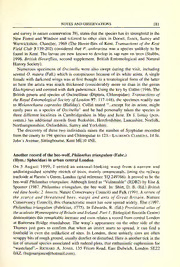
Another record of the bee-wolf, Philanthus triangulum (Fabr.) (Hym.: Sphecidae) in urban central London PDF
Preview Another record of the bee-wolf, Philanthus triangulum (Fabr.) (Hym.: Sphecidae) in urban central London
NOTESANDOBSERVATIONS 181 and survey innatureconservation 39), states thatthe species has its strongholdinthe New Forest and Windsor and referred to other sites in Dorset, Essex, Surrey and Warwickshire. Chandler, 1969 (The Hover-flies of Kent. Transactions ofthe Kent Field Club 3:139-202) considered that P. anthracina was a species unlikely to be found in Kent. The larvae are now known to develop in sap runs on trees (Stubbs, H 1996. British overflies, second supplement. British Entomological and Natural History Society). Numerous specimens of Oscinella were also swept during the visit, including several O. maura (Fall.) which is conspicuous because of its white arista. A single female with darkened wings was at first thought to a teratological form ofthe latter as here the arista was much thickened (considerably more so than in the genus Elachiptera) and covered with darkpubescence. Using the key by Collin (1946. The British genera and species of Oscinellinae (Diptera, Chloropidae). Transactions of the Royal Entomological Society of^London 97: 117-148), the specimen readily ran to Melanochaeta capreolus (Haliday). Collin stated "...except for its arista, might easily pass as a species of Oscinella" and he had personally taken the species in three different localities in Cambridgeshire in May and June. Dr J. Ismay (pers. comm.) has additional records from Berkshire, Herefordshire, Lancashire, Norfolk, Northamptonshire, Oxfordshire, Surrey andYorkshire. The discovery of these two individuals raises the number of Syrphidae recorded from thecountyto 194 species andChloropidae to 123.-LaurenceClemons, 14 St. John'sAvenue, Sittingboume, KentME104NE. Anotherrecord ofthe bee-wolf,Philanthustriangulum (Fabr.) (Hym.: Sphecidae) in urban central London On 5 August 1999, I netted an unusual-looking wasp from a narrow and undistinguished scrubby stretch of trees, mainly ornamentals, lining the railway trackside at Parson's Green, London (grid reference TQ 249766). It proved to be the bee-wolfPhilanthus triangulum. Although listed as "Vulnerable" (RDB2) by Else & Spooner (1987. Philanthus triangulum, the bee wolf. In: Shirt, D. B. (Ed.) British reddatabooks:2. Insects. Nature Conservancy Council) andFalk (1991.A reviewof the scarce and threatened bees, wasps and ants of Great Britain. Nature Conservancy Council), this characteristic insect has now spread widely. Else (1997. Philanthus triangulum (Fabricius, 1775). In Edwards, R. (Ed.) Provisional atlas of theaculeateHymenopteraofBritain andIreland. PartI. Biological Records Centre) demonstrates this remarkable increase andevenrelates arecord from central London at Battersea Bridge roundabout. The wasp's appearance on the other side of the Thames just goes to confirm that when an insect starts to spread, it can find a foothold in even the unlikeliest of sites. In London, these unlikely sites are often scrappybitsofroughground, usuallyderelictordisturbed. Here is anothertickin the list ofunusual species associated with ruderal plots, that enthusiastic euphemism for "wasteland".- Richard A. Jones, 135 Friem Road, East Dulwich, London SE22 OAZ. (bugmanjones(a)hotmail.com).
